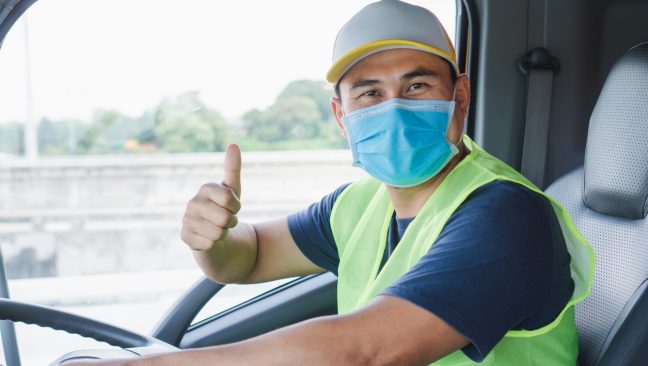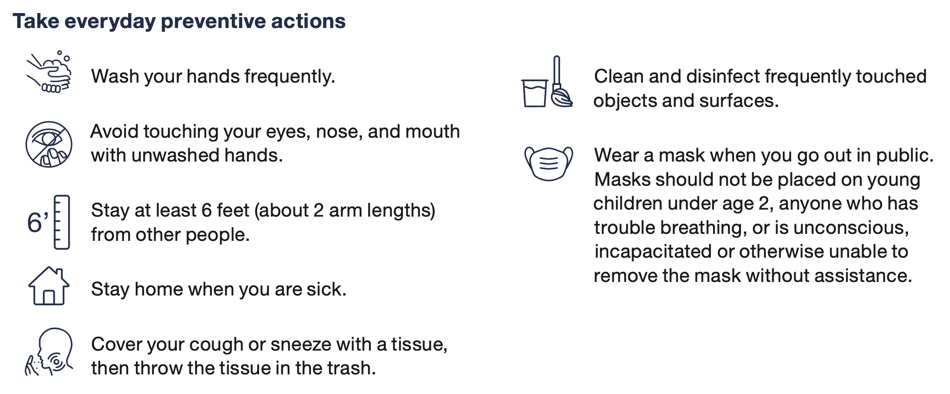
COVID-19 is a risk for all populations, but truck drivers and others in the transportation industry have some unique risks for exposure when out on the road. Follow these guidelines from the CDC to keep yourself, your employer, and your community safe.

Stay at least 6 feet away from dock workers, store workers, and others when possible.
- Limit time spent outside of the truck cab during fueling, loading and unloading, and at rest and truck stops.
- Use paperless, electronic invoicing for fueling, deliveries, and other tasks, when available.
Contact facilities in advance to make an appointment for unloading of cargo. Be aware that some facilities may not grant access to restrooms, and plan as best you can.
Use radio/phone to talk with dock managers or other drivers, if possible.
Pack food, water, and supplies to limit the number of stops.
Avoid shaking hands.
Keep your truck well-ventilated.
- Use paperless, electronic invoicing for fueling, deliveries, and other tasks, when available.
- Do not share personal protective equipment (PPE) (such as vests, safety glasses, hard hats), tools, phones, radios, or other personal items.
- Use pre-qualified truck stops or hotels identified by your employer as having appropriate COVID-19 protections.
- If any directive from your employer or a shipper is unclear, ask questions.
Wear a cloth mask in public, and at work, even when social distancing.
Cloth masks may prevent people who don’t know they have the virus from spreading it to others. The spread of COVID-19 can be reduced when cloth masks are used along with other preventive measures, including social distancing. A universal face covering policy can be effective in preventing the transmission of the virus in close-contact interactions.
- Be careful when putting on and taking off cloth masks:
- Don’t touch your cloth mask while wearing it.
- Don’t touch your face, mouth, nose, or eyes while taking off the cloth mask.
- Wash your hands before putting on and after taking off the cloth mask.
- Wash the mask after each use.
- Ensure cloth masks do not create a new risk (for example, interferes with driving or vision, or contributes to heat related illness) that exceeds their COVID-19 related benefits of slowing the spread of the virus.
- When team driving or ride-alongs are required, wear a cloth mask when sharing the cab with someone who doesn’t live with you and you can’t stay 6 feet apart.
- For those with sensory, cognitive, or behavioral issues, cloth masks may be difficult to wear, especially for extended periods of time. CDC provides information on adaptations and alternatives that should be considered when cloth masks may not be feasible.
- If you are concerned about the use of cloth masks at your workplace, discuss them with your employer.
- Consider carrying a spare cloth mask.
Clean and disinfect frequently touched objects or surfaces.
- Clean the following areas on a routine basis or at least daily:
- In the truck cab (driver door handle, steering wheel, seat belt and buckle, arm and head rest, seat cover, turn signal, wiper controls, dashboard, air ducts, radio, and temperature controls)
- In the sleeper berth (light switches, mattress tray, temperature controls, and other flat surfaces)
- If a third party must have access to the interior of your truck (for example, mechanics, other drivers, inspectors), request that the third party clean and disinfect the truck before turning it back over to you.
- Avoid touching your face, mouth, nose, or eyes when handling frequently touched items.
- Follow the directions on the cleaning product’s label.
Wash your hands regularly with soap and water for at least 20 seconds. You don’t need to wear gloves if you wash your hands regularly (unless they are already required for your job).
- Use an alcohol-based hand sanitizer containing at least 60% alcohol if soap and water aren’t available.
- Wash your hands at these key times:
- Before entering and leaving the cab, including deliveries, loading and unloading of cargo, rest breaks, fueling, and other activities.
- Before, during, and after preparing food.
- Before eating food.
- After using the toilet.
- After blowing your nose, coughing, or sneezing.
- After putting on, touching, or removing cloth masks.
- Before and after work and work breaks.
- Before and after fueling.
Do not touch your face, mouth, nose, or eyes. Cover your coughs and sneezes.
- Use tissues to cover your mouth and nose when you cough or sneeze or use the inside of your elbow.
- Throw used tissues in a lined trash receptacle.
- Wash your hands with soap and water for at least 20 seconds or use hand sanitizer with at least 60% alcohol when soap and water are not available.
For more information on what truck drivers need to know about COVID-19, visit the CDC website.
